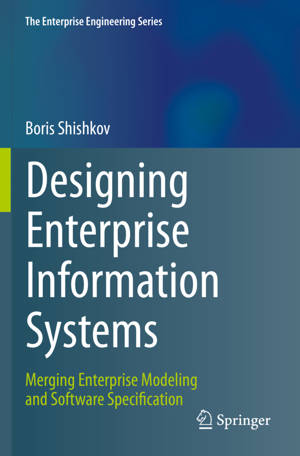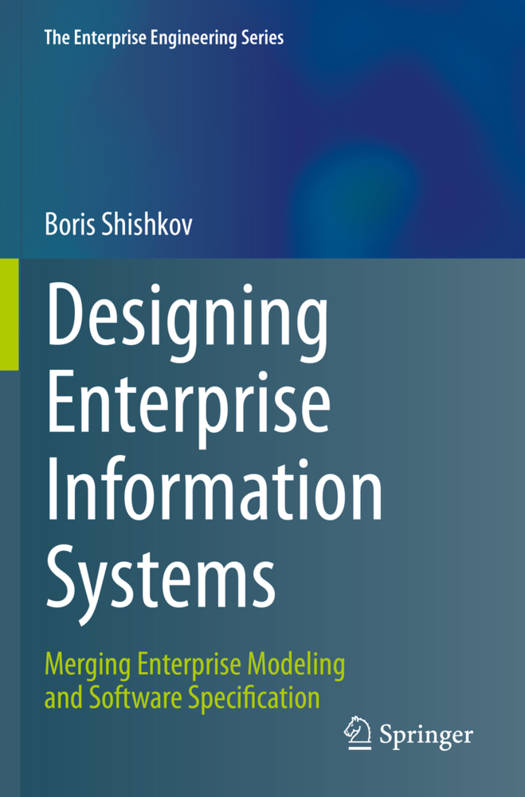
- Afhalen na 1 uur in een winkel met voorraad
- Gratis thuislevering in België vanaf € 30
- Ruim aanbod met 7 miljoen producten
- Afhalen na 1 uur in een winkel met voorraad
- Gratis thuislevering in België vanaf € 30
- Ruim aanbod met 7 miljoen producten
Zoeken
Designing Enterprise Information Systems
Merging Enterprise Modeling and Software Specification
Boris Shishkov
€ 63,45
+ 126 punten
Uitvoering
Omschrijving
This book brings together enterprise modeling and software specification, providing a conceptual background and methodological guidelines that concern the design of enterprise information systems. In this, two corresponding disciplines (enterprise engineering and software engineering) are considered in a complementary way. This is how the widely recognized gap between domain experts and software engineers could be effectively addressed.
The content is, on the one hand, based on a conceptual invariance (embracing concepts whose essence transcends the barriers between social and technical disciplines) while on the other, the book is featuring a modeling duality, by bringing together social theories (that are underlying with regard to enterprise engineering) and computing paradigms (that are underlying as it concerns software engineering). In addition, the proposed approach as well as its guidelines and related notations further foster such enterprise-software modeling, by facilitating modeling generations and transformations. Considering unstructured business information in the beginning, the modeling process would progress through the methodological construction of enterprise models, to reach as far as a corresponding derivation of software specifications. Finally, the enterprise-software alignment is achieved in a component-based way, featuring a potential for re-using modeling constructs, such that the modeling effectiveness and efficiency are further stimulated. For the sake of grounding the presented studies, a case study and illustrative examples are considered. They are not only justifying the idea of bringing together (in a component-based way) enterprise modeling and software specification but they are also demonstrating various strengths and limitations of the proposed modeling approach.
The book was mainly written for researchers and graduate students in enterprise information systems, and also for professionals whose work involves the specification and realization of such systems. In addition, researchers and practitioners entering these fields will benefit from the blended view on enterprise modeling and software specification, for the sake of an effective and efficient design of enterprise information systems.
The content is, on the one hand, based on a conceptual invariance (embracing concepts whose essence transcends the barriers between social and technical disciplines) while on the other, the book is featuring a modeling duality, by bringing together social theories (that are underlying with regard to enterprise engineering) and computing paradigms (that are underlying as it concerns software engineering). In addition, the proposed approach as well as its guidelines and related notations further foster such enterprise-software modeling, by facilitating modeling generations and transformations. Considering unstructured business information in the beginning, the modeling process would progress through the methodological construction of enterprise models, to reach as far as a corresponding derivation of software specifications. Finally, the enterprise-software alignment is achieved in a component-based way, featuring a potential for re-using modeling constructs, such that the modeling effectiveness and efficiency are further stimulated. For the sake of grounding the presented studies, a case study and illustrative examples are considered. They are not only justifying the idea of bringing together (in a component-based way) enterprise modeling and software specification but they are also demonstrating various strengths and limitations of the proposed modeling approach.
The book was mainly written for researchers and graduate students in enterprise information systems, and also for professionals whose work involves the specification and realization of such systems. In addition, researchers and practitioners entering these fields will benefit from the blended view on enterprise modeling and software specification, for the sake of an effective and efficient design of enterprise information systems.
Specificaties
Betrokkenen
- Auteur(s):
- Uitgeverij:
Inhoud
- Aantal bladzijden:
- 234
- Taal:
- Engels
- Reeks:
Eigenschappen
- Productcode (EAN):
- 9783030224431
- Verschijningsdatum:
- 29/11/2020
- Uitvoering:
- Paperback
- Formaat:
- Trade paperback (VS)
- Afmetingen:
- 156 mm x 234 mm
- Gewicht:
- 353 g

Alleen bij Standaard Boekhandel
+ 126 punten op je klantenkaart van Standaard Boekhandel
Beoordelingen
We publiceren alleen reviews die voldoen aan de voorwaarden voor reviews. Bekijk onze voorwaarden voor reviews.











